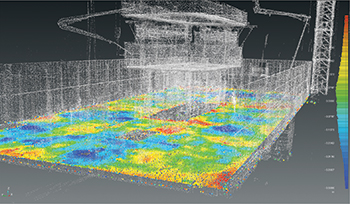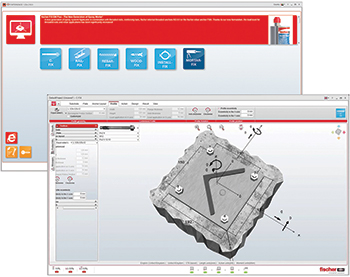
 BuildIt Construction enables simple checks such as floor flatness.
BuildIt Construction enables simple checks such as floor flatness.
As the construction and built environment industry moves into a digital era, where accountability is very important, solutions provided within specific areas of expertise are being applied to extended areas of work.
Faro’s development team has been working hard to embed traceable construction concepts that complement or replace traditional workflows.
Its BuildIt Construction software allows almost completely automated quality assurance (QA) and quality control (QC) management processes to take place on site and enables construction professionals to continuously compare real-world conditions against CAD models.
The tool is focused on the ability to quickly and efficiently verify if objects are placed correctly during or after construction (from openings and columns to rebar). But the possibilities with BuildIt Construction are far-reaching and applicable to many professionals in the industry.
Opportunities can be identified for other stakeholders as well, such as in the design, procurement and operational phases of built assets and making them ‘real’.
 |
|
Users can check if work has been undertaken to the most accurate of tolerances at a micro level. |
For designers
Designers of almost any discipline can potentially learn a lot from reports generated from BuildIt Construction. Whilst on the surface, it may initially seem that an on-site, that the construction issue is the fault of a contractor or sub-contractor, it could perhaps offer insight as to the cause of the issue: was the item was constructed in the wrong place, did the contractor amend the design, or did the original design not give enough thought to constructability?
The question then passes to the designer: Is the reported deviation related to his design errors/assumptions, and are there constructability issues?
The identified deviations shouldn’t be seen as a ‘policing’ of the process, but rather a helping hand to ensure the best possible result.
Now with the ability to import native Autodesk Revit files, the time taken for a model comparison workflow for Revit file ‘creators’ or ‘consumers’ is greatly reduced and the process simplified.
For non-Autodesk Revit BIM users, the import of IFC (Industry Foundation Classes) files is also now possible, widening the ability to import and check against files from many other building information modelling (BIM) authoring tools.
For contractors
The benefits are more obvious to the ‘original’ target users of this technology, such as the ability to check, in ‘near-real-time’, what has been constructed in reality against what has been designed and specified by the design team.
As the stakeholder most likely to often undertake the data capture work on site, the ability to register Faro Focus Laser Scanner data files directly during import reduces the time from capturing data to the validation report by half – heading towards a seamless workflow, with almost real-time comparisons.
Similar techniques provide evidence that the correct standards have been met whether these are ‘simple’ checks, such as floor flatness to ensure unnecessary rework is avoided; checking pre-cambered steel beams for their appropriate settlement; or checking surfaces for smoothness prior to the application of decorative finishes.
The BuildIt Construction library of report templates is increasing: templates such as floor flatness checks to the American Standard ASTM E1155 are available and can be amended to suit other international standards.
On a larger scale, early warning for potential design coordination issues between trade contractors is now possible as is determining accuracy in critical situations. Greater accuracy and the ability to see coordination issues provides greater flexibility in finding solutions.
For project managers
According to KPMG’s 2015 Global Construction Survey: “One of the industry’s most pressing needs is well-trained project managers to complete projects on time and on budget.”
And while this report is three years old, the requirement still exists. Tools such as BuildIt Construction enable much greater insight into construction progress and traceability, enabling better decision making at project management level.
The BuildIt Construction development team uncovered technology that can automate repetitive tasks, providing users with the capability to create (in a user-friendly fashion) bespoke workflows to increase speed and efficiency for on-site reporting benefitting both project managers and contractors.
In addition, communicating with other stakeholders in an intuitive way is now possible through the export of colour-coded models, including the ability to customise the colour scale in deviation. This is an essential step in the communication of issues accompanied by the technical proof, simplifying construction project management by identifying and resolving issues quickly with traceability.
For cost consultants
Whether checking if work has been undertaken to the most accurate of tolerances at a micro level or simply reporting overall progress at a macro level, BuildIt Construction can help cost consultants plan and report the financial aspects of a project, enabling greater control, reduced risk and increased clarity of what has been built and to what standards.
Faro continues its investment in the platform to enable a wider usage by even more stakeholders in the construction industry. The focus is very much on improving the users’ adoption of the tool into their workflows by increasing usability. Obviously this will produce much better outcomes than what has traditionally been. At the moment, this is driven by development roadmap themes such as data consistency and even faster creation of deliverables.
Integrating BuildIt Construction into the wider Faro product portfolio offers extended opportunities for automating many repetitive and laborious built environment tasks.
User scenarios above are just a handful of the current capabilities of BuildIt Construction in relation to traceable construction.
With this technology – borrowed from years of use in the manufacturing industry - playing a vital part in checks, project stakeholders can very soon be seen demanding more stringent quality from their counterparts – and tools are now available to ensure this, with the added traceability.
*Headquartered in Lake Mary, Florida, Faro is a trusted source for 3D measurement, imaging and realisation technology. It has a technology centre and manufacturing facility covering 8,400 sq m in Exton, Pennsylvania.





















_0001.jpg)


.jpg)
















.jpg)








.jpg)



